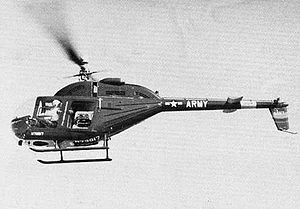Bell YOH-4
| YHO-4 / YOH-4 | |
|---|---|

| |
| YOH-4A LOH in flight | |
| Role | Observation/scout helicopter |
| National origin | United States |
| Manufacturer | Bell Helicopter |
| First flight | 8 December 1962[1] |
| Primary user | United States Army |
| Number built | 5[2] |
| Developed into | Bell 206 JetRanger |
The Bell YOH-4 (originally YHO-4) was a single-engine, single-rotor light helicopter, developed for the United States Army's Light Observation Helicopter program. While the YOH-4A was unsuccessful in the original LOH competition, Bell redesigned it as the sleek Bell 206A JetRanger for the commercial market, and enjoyed instant and lasting success. In 1967, the Army reopened the LOH competition, and the 206A-based OH-58 Kiowa was selected.
Development[]
On 14 October 1960, the United States Navy solicited responses from 25 aircraft manufacturers to a request for proposals (RFP) on behalf of the Army for the Light Observation Helicopter (LOH). Bell entered the competition along with 12 other manufacturers, including Hiller Aircraft and Hughes Tool Co., Aircraft Division.[3] In January 1961, Bell submitted Design 250 (D-250), which would eventually be designated as the YHO-4.[4] On 19 May 1961, Bell and Hiller were announced as winners of the design competition.[note 1][5]

Bell produced five prototypes of the D-250, as Model 206, in 1962, the first prototype making its maiden flight on 8 December 1962.[1] That same year, all aircraft began to be designated according to the new Joint Services designation system, so the prototype aircraft were redesignated YOH-4A.[1] The YOH-4A also became known as the Ugly Duckling in comparison to the other contending aircraft.[6] Following a flyoff of the Bell, Hughes and Fairchild-Hiller prototypes, the Hughes OH-6 was selected in May 1965.[7]
After the failed military contract bid, Bell attempted to market the Model 206, but it did not fare well commercially. Bell's market research showed that customers found the body design mostly unpalatable. Bell would eventually redesign the body of the airframe to a more sleek and aesthetic design and reintroduced it as the Bell 206A JetRanger.[8]
Variants[]

- YHO-4
- Bell 206 powered by a 250shp T63-A-5 for Army evaluation, five built later redesignated YOH-4A
- YOH-4A
- YHO-4s redesignated.
Operators[]
Surviving aircraft[]
The remaining OH-4A 62-4202 is in storage at the United States Army Aviation Museum, Fort Rucker, Alabama.[9]
Specifications (OH-4A)[]
Data from U.S. Army Aircraft Since 1947[2]
General characteristics
- Crew: 1 pilot
- Capacity: up to 3 passengers or 2 stretchers
- Length: 38 ft 8 in (11.79 m)
- Height: 8 ft 10 in (2.69 m)
- Empty weight: 1,536 lb (697 kg)
- Max takeoff weight: 2,537 lb (1,151 kg)
- Powerplant: 1 × Allison T63-A-5 turboshaft engine, 250 shp (190 kW)
- Main rotor diameter: 33 ft 3 in (10.13 m)
- Main rotor area: 842.3 sq ft (78.25 m2)
- Blade section: - NACA 0012 mod (11.3%)[10]
Performance
- Maximum speed: 117 kn (135 mph, 217 km/h)
- Cruise speed: 96 kn (110 mph, 178 km/h)
- Range: 246 nmi (283 mi, 456 km)
- Service ceiling: 20,000 ft (6,100 m)
See also[]
- U.S. Helicopter Armament Subsystems
Related development
Aircraft of comparable role, configuration, and era
Related lists
References[]
Notes[]
- ^ The Navy, which was assisting the Army in the selection phase, recommended the Hiller Model 1100, while the Army team preferred the Bell D-250, and then the 1100. The Selection Board accepted both aircraft for an evaluation test. Afterwards, the acting Army Chief of Staff directed the Selection Board to include the Hughes 369 in the fly-off competition.
Citations[]
- ^ a b c Johan Visschedijk (16 October 2003). "Bell 206 JetRanger". Archived from the original on September 20, 2006.
- ^ a b Harding, Stephen (1997). U.S. Army Aircraft Since 1947. Atglen, PA, USA: Schiffer Publishing Ltd. p. 42. ISBN 978-0-933424-53-1.
- ^ Remington, Steve. "The Cessna CH-1 Helicopter". CollectAir.com
- ^ Beechy, Robert. "U.S Army Aircraft Acquisition Programs". Archived 2006-09-20 at WebCite Uncommon Aircraft 2006. 18 November 2005. Accessed on 19 September 2006.
- ^ Spangenberg, George A. George A. Spangenberg Oral History Archived 2008-09-10 at the Wayback Machine. www.spangenberg.org. Judith Spangenberg-Currier, ed. pp.187-190. Accessed on 29 April 2008.
- ^ Aastad, Andy. "The Introduction to the JetRanger". Archived September 10, 2008, at the Wayback Machine Rotor Magazine. Helicopter Association International. Winter 2006-2007. Accessed on 5 April 2009.
- ^ Spenser 1998, p. 263.
- ^ "American Helicopter Museum: Bell 206 JetRanger". Archived from the original on 2006-09-20. Retrieved 2009-06-28.
- ^ 8 December 1962
- ^ Lednicer, David. "The Incomplete Guide to Airfoil Usage". m-selig.ae.illinois.edu. Retrieved 16 April 2019.
- Bibliography
- Spenser, Jay P. "Bell Helicopter". Whirlybirds, A History of the U.S. Helicopter Pioneers. University of Washington Press, 1998. ISBN 0-295-98058-3.
External links[]
| Wikimedia Commons has media related to OH-58 Kiowa. |
- United States military helicopters
- 1960s United States military reconnaissance aircraft
- 1960s United States helicopters
- Bell aircraft
- Single-turbine helicopters
- Aircraft first flown in 1962